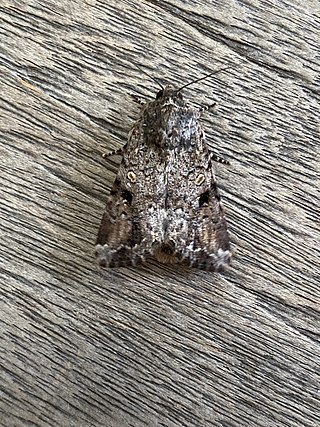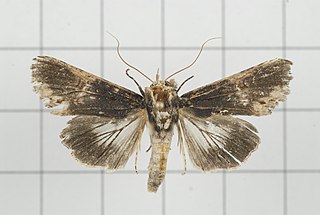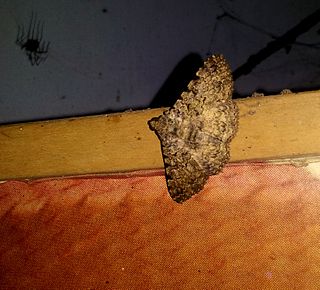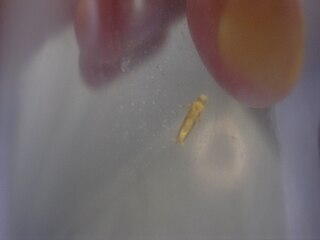
Schreckensteinioidea is a superfamily in the insect order Lepidoptera containing a single family, Schreckensteiniidae, or "bristle-legged moths", because of the stout spines on the hindlegs. The superfamily and family were both described by Thomas Bainbrigge Fletcher in 1929. The relationships of this family within the group apoditrysia are currently uncertain. One of the species, the blackberry skeletoniser, is widespread and common across Europe and has been introduced as a biological control to Hawaii, whilst three species of Corsocasis occur in South East Asia.
The poko noctuid moth is a moth in the family Noctuidae. The species was first described by Arthur Gardiner Butler in 1881.

Lantanophaga pusillidactyla, the lantana plume moth, is a moth of the family Pterophoridae. It is native to the southern United States, Mexico, the Caribbean, and South America. It was introduced to Australia accidentally in 1936 and is now found from Sydney to Cairns along the coast. It has also been introduced to Hawaii in 1902, Pohnpei in 1948, and Palau in 1960 for biological control. It has since been recorded from Yap in 1987–1988 and is now distributed on all islands of the Mariana and Caroline Islands where the host plant is found, except Aguijan.

Exelastis pumilio is a moth of the family Pterophoridae. It has worldwide tropical distribution, including Argentina, Brazil, Colombia, Costa Rica, Cuba, Ecuador, Guadeloupe, Jamaica, Mexico, Puerto Rico, Suriname, Japan, Micronesia, South Africa the Virgin Islands as well as Queensland and New Guinea.

Udara blackburni, the Koa butterfly, is a butterfly in the family Lycaenidae that is endemic to Hawaiʻi. It is also known as Blackburn's butterfly, Blackburn's bluet, Hawaiian blue or green Hawaiian blue.

Spodoptera mauritia, the lawn armyworm or paddy swarming caterpillar, is a moth of the family Noctuidae. The species was first described by Jean Baptiste Boisduval in 1833. Able to eat many types of food, it is a major pest throughout the world.

Stictoptera cucullioides is a moth of the family Euteliidae. It is found from the Indo-Australian tropics of India, Sri Lanka to the Bismarck Islands and Queensland. It is an introduced species in Hawaii, where it is found on Oahu, Molokai, Maui and Hawaii.

Polydesma boarmoides is a species of moth in the family Erebidae. It was first described by Achille Guenée in 1852. The species is found from the Indo-Australian tropics east from Sri Lanka, to Australia, Myanmar, Fiji and New Caledonia. It has also been recorded from the Marianas, Carolines, Society Islands and Hawaii.
Trissodoris honorariella, the pandanus leaf perforator or pandanus hole-cutter moth, is a small cosmet moth species. It belongs to subfamily Cosmopteriginae and is the type species of the genus Trissodoris. Baron Thomas Walsingham in 1907 had specimens from both ends of the species' range – New Guinea and Pitcairn Island – which he described as separate species Stagmatophora honorariella and S. quadrifasciata in the same work. But his mistake was soon recognized, and when Edward Meyrick established the genus Trissodoris in 1914, he chose the former name to be valid.
Crypsithyrodes concolorella is a moth of the family Tineidae. It was first described by Francis Walker in 1863. It has been recorded from Australia, French Polynesia, the Seychelles, Fiji, Hawaii, Java, Rennell Island, the Caroline Islands and Malaya.
Praeacedes is a monotypic moth genus in the family Tineidae first described by Hans Georg Amsel in 1954. Its only species, Praeacedes atomosella, was first described by Francis Walker in 1863. It has a wide range and has been recorded from Europe, Australia, Hawaii, India, Malaysia, Solomon Islands, Easter Island, Mauritius, Madagascar, Réunion, South America and North America. The species has commonly been misidentified in various parts of the world.

Monopis meliorella, the blotched monopis moth, is a moth of the family Tineidae. It was first described by Francis Walker in 1863. It has been recorded from Australia and Hawaii.

Dryadaula terpsichorella, the dancing moth, is a moth of the family Tineidae. It is native to south-eastern Polynesia, Samoa and Fiji, but has also been recorded from Hawaii and more recently from Florida and California. The common name is derived from the characteristic dancelike gyrations it goes through when it alights. It was first described by August Busck in 1910.

Erechthias minuscula, the erechthias clothes moth, is a moth of the family Tineidae. It was first described by Lord Walsingham in 1897. It is widespread and has been recorded from Africa, Sri Lanka, Java, Australia, the Caroline Islands, Fiji, Samoa, the Marquesas, the West Indies, Hawaii and Florida.
Dichomeris acuminata, the alfalfa leaf tier, is a moth of the family Gelechiidae. It was first described by Otto Staudinger in 1876. It is a widely distributed species, being known from India, Myanmar, and Sri Lanka southwest to the Seychelles, Mauritius and Réunion and on to Egypt, east and South Africa and southern Europe. Eastward from India it extends through Indonesia and Malaysia to Taiwan and Australia. It is also found in Japan, the West Indies, North America and Hawaii.

Stoeberhinus testaceus, the potato moth, is a gelechioid moth, supposedly the only species of its genus Stoeberhinus. However, the genus might also include some related moths presently placed in Autosticha. It belongs to the subfamily Autostichinae, which is either placed in the concealer moth family (Oecophoridae), or in an expanded Autostichidae.

Hellula undalis, the cabbage webworm or Old World webworm, is a moth of the family Crambidae. It is a widespread species which is found from Europe across Asia to the Pacific. It was first described from Italy.

Pyralis manihotalis is a moth of the family Pyralidae described by Achille Guenée in 1854.

Cadra figulilella, the raisin moth, is a moth of the family Pyralidae. The raisin moth is known most commonly as a pest that feeds on dried fruits, such as the raisin and date. It covers a range that includes much of the world, primarily situating itself in areas of California, Florida, the Eastern Mediterranean region, and some parts of Africa, Australia, and South America. The moth prefers to live in a hot, arid climate with little moisture and plentiful harvest for its larvae to feed on. Study of this species is important due to the vast amount of economic damage it causes yearly and worldwide to agriculture crops.

Crocidosema lantana, the lantana flower-cluster moth or lantana tortricid moth, is a moth of the family Tortricidae. It was first described by August Busck in 1910. It is native to Mexico and the southern United States, but was introduced to Hawaii in 1902, Australia in 1914 and the Caroline Islands in 1948 and 1949 to aid in the control of Lantana weeds. It has also been recorded from Yunnan, China and in Sri Lanka.















